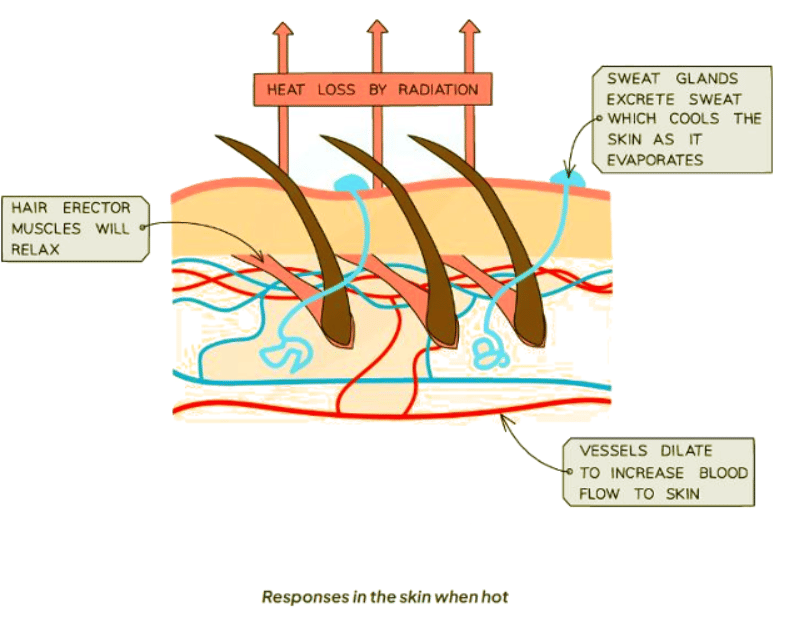Class 10 Exam > Class 10 Notes > Biology for GCSE/IGCSE > Homeostasis: Temperature Control
Homeostasis: Temperature Control | Biology for GCSE/IGCSE - Class 10 PDF Download
The Skin & Homeostasis
- Regulating body temperature is a fundamental homeostatic process.
- Homeostasis entails sustaining a stable internal environment.
- This involves maintaining internal conditions, like temperature, blood pressure, and glucose concentration, within specific boundaries to support cellular functions and overall organism survival.
- Human body temperature is typically maintained at approximately 37°C, optimal for enzyme activity.
- Exceeding this temperature threshold can lead to enzyme denaturation, compromising their efficiency in catalyzing vital reactions such as respiration.
The Structure of the Skin

Temperature Regulation by the Skin
- Temperature regulation is overseen by the brain, which houses receptors that monitor blood temperature.
- Additionally, the skin possesses temperature receptors, relaying sensory signals to the brain through sensory neurons.
- The brain reacts to these inputs by dispatching nerve impulses to skin effectors, aiming to sustain the temperature close to the optimal 37°C.
- Fatty tissue beneath the dermis serves as an insulating layer, minimizing excessive heat loss from the body through the skin.

Responses to changes in temperature

Vasoconstriction & Vasodilation
- In response to cold, vasoconstriction occurs, wherein arterioles leading to skin capillaries constrict, diminishing blood flow.
- This constriction minimizes heat loss from blood via radiation by reducing blood exposure to the skin surface.
- Conversely, during heat exposure, vasodilation takes place, wherein blood vessels leading to skin capillaries dilate.
- Vasodilation facilitates heat dissipation as blood circulates more rapidly through the skin, augmenting heat loss through radiation.


Question for Homeostasis: Temperature ControlTry yourself: What is the purpose of homeostasis in the human body?View Solution
The document Homeostasis: Temperature Control | Biology for GCSE/IGCSE - Class 10 is a part of the Class 10 Course Biology for GCSE/IGCSE.
All you need of Class 10 at this link: Class 10
|
110 videos|210 docs|33 tests
|
FAQs on Homeostasis: Temperature Control - Biology for GCSE/IGCSE - Class 10
| 1. How does vasoconstriction and vasodilation play a role in temperature control? |  |
Ans. Vasoconstriction helps to conserve heat by narrowing blood vessels near the surface of the skin, reducing blood flow and heat loss. On the other hand, vasodilation increases blood flow to the skin's surface, allowing heat to dissipate and cool the body.
| 2. How does the skin help maintain homeostasis in the body? |  |
Ans. The skin plays a crucial role in homeostasis by regulating body temperature through processes like sweating, vasoconstriction, and vasodilation. It also helps to protect the body from external threats and maintains hydration levels.
| 3. What are some factors that can disrupt the skin's ability to maintain homeostasis? |  |
Ans. Factors like extreme temperatures, dehydration, certain skin conditions, and exposure to harmful chemicals can disrupt the skin's ability to maintain homeostasis. These factors can impact the skin's barrier function and its ability to regulate temperature effectively.
| 4. How does the body respond to changes in temperature to maintain homeostasis? |  |
Ans. When the body is exposed to high temperatures, it responds by increasing sweat production and dilating blood vessels to release heat. In contrast, when the body is exposed to cold temperatures, vasoconstriction occurs to conserve heat and shivering helps generate warmth.
| 5. How does the skin's response to temperature changes contribute to overall health and well-being? |  |
Ans. The skin's ability to regulate temperature is essential for maintaining overall health and well-being. Proper temperature control helps prevent overheating or hypothermia, supports immune function, and promotes optimal organ function.
Related Searches















